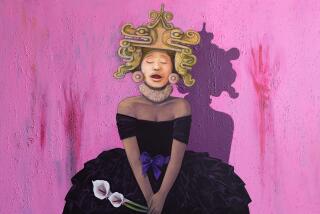Rodolfo Morales; Mexican Artist
Mexican artist Rodolfo Morales, a guiding spirit of Oaxacan art and an heir to the artistic legacy of his more celebrated countryman Rufino Tamayo, died Tuesday night at a clinic in Oaxaca. He was 75.
Morales was undergoing treatment for cancer of the pancreas.
A prolific painter of Mexican village life who merged aspects of surrealism with magic realism, Morales is best known for vividly colored, dreamlike images that portray everything from somber women engaged in daily chores to nuns riding bicycles, frolicking angels and lots of little dogs. Much of his work was inspired by the agrarian village of Ocotlan, where he was born, raised and returned to paint during the last 16 years of his life.
Born on May 8, 1925, Morales began to draw as a child and studied at the Academia de San Carlos in Mexico City from 1948 to 1953. He began a career as an art teacher at the Escuela Nacional Preparatoria in Mexico City and spent the next 32 years teaching drawing to high school students, both to support himself and to share his love of art.
Morales exhibited his own paintings and collages while teaching, but he labored in obscurity until 1975, when Tamayo saw an exhibition of Morales’ work in Cuernavaca and helped him make important art-world connections. In 1985, after a decade of showing and selling his work on the international market, Morales gave up teaching and returned to Ocotlan to paint full time.
His work has been shown in many museums and galleries in Europe and the United States as well as Mexico. He also won mural commissions for government-sponsored projects in Mexico City and Oaxaca. A retrospective exhibition of his work inaugurated the Galeria Arte de Oaxaca in 1994. Another retrospective opened at the Mexican Museum in San Francisco in 1996 and then toured the United States and Canada. The largest show of his work in Southern California appeared at the Museum of Latin American Art in Long Beach in 1997.
As Morales’ fame spread, some critics panned his work as primitive and sentimental or chided him for perpetuating a moribund folkloric style. He was also dismissed as the Mexican Chagall, partly because of his penchant for airborne figures.
But he also garnered praise from curators and critics. In The Times’ review of the Long Beach exhibition, art critic William Wilson noted the influence of Chagall and Tamayo but concluded that “Morales’ value as an artist lies in his inability to finally do anything but paint with soul.” Rather than judging his accomplishments in terms of international Modernism, Wilson said, he should be viewed “as one who raised traditional Mexican ex-voto painting to a new stature.”
To Ilona Katzew, curator of Latin American art at the Los Angeles County Museum of Art, Morales is “a very important artist--one of the great Oaxacan artists in the tradition of Tamayo and Toledo--and a wonderful man who was very humble, very down-to-earth.”
In his art, Morales created a visual vocabulary based on village life and traditions that conveyed his love for his homeland and its people, she said. But he also had considerable stature as a community activist and philanthropist, she noted.
“He was important to his community because he was very interested in helping to educate children and in restoring baroque buildings that are essential to the rich cultural heritage of the region,” Katzew said.
Indeed, in 1992, after Morales gained wealth he had never dreamed of, he established the Rodolfo Morales Foundation and financed it with proceeds from sales of his artworks. The foundation planted trees in arid neighborhoods, helped children learn to use computers and restored Spanish colonial churches in Ocotlan and the surrounding area.
“I never thought I’d have money,” Morales told the Wall Street Journal in 1999, in an article that credited him with pumping $2.5 million into the community. “Now I know what it’s good for.”
More to Read
Sign up for Essential California
The most important California stories and recommendations in your inbox every morning.
You may occasionally receive promotional content from the Los Angeles Times.










